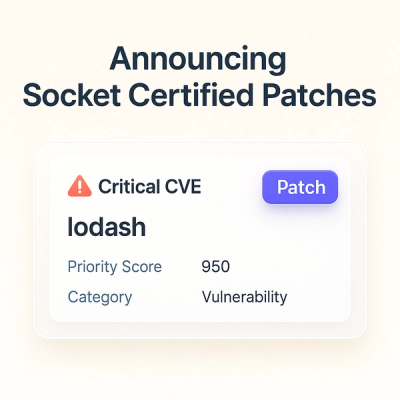
Product
Announcing Bun and vlt Support in Socket
Bringing supply chain security to the next generation of JavaScript package managers
seadragon
Advanced tools
OpenSeadragon is an open-source, web-based viewer for displaying high-resolution zoomable images. A viewer is displayed by passing paths to a set of image tiles and a DZI descriptor file to a function provided by the OpenSeadragon Javascript library.
OpenSeadragon doesn't handle the creation of the required tile images or descriptor file; this gem provides methods for creating tiles and descriptor files along with a Rails helper method for rendering image viewers in your Rails view templates.
There are a number of Ruby Gems that provide OpenSeadragon functionality. The Openseadragon gem packages the OpenSeadragon Javascript assets and provides helpers for using them, but leaves the descriptor and tile generation to the end-user. SeadragonPaperclip is a processor for the Paperclip gem that generates tiles, but it is tied to Paperclip and doesn't generate descriptor files or provide helper methods. This gem provides everything required for generating and displaying Deep Zoom Images on a webpage.
Seadragon uses Rmagick to process source images - this requires ImageMagick to be installed on your system.
Install the latest stable release:
$ gem install seadragon
In Rails, add it to your Gemfile:
gem 'seadragon'
Restart your server if required to apply the changes.
Before a viewer can be displayed, the required tile images and descriptor file must be created.
First, create a Seadragon::Slice instance, passing to it the path to the image you want to tile, the output directory and a unique handle, e.g.
slicer = Seadragon::Slicer.new({
source_path: '/images/starrynight.jpg',
tiles_path: '/www/public_html/deep_zoom_images',
handle: 'starrynight'
})
To generate the image tiles, run:
slicer.slice!
The descriptor file can the be generated by calling the write_dzi_specification method:
slicer.write_dzi_specification
The steps above would create a starrynight_files directory in /www/public_html/deep_zoom_images with a subfolder of tile images for each zoom level (calculated according to the dimensions of the image). The descriptor file, configuration information in JSON format required by OpenSeadragon, would be saved to /www/public_html/deep_zoom_images/starrynight.dzi.
To display a viewer in your view, first ensure the gem's Javascript is referenced from application.js in your app:
//= require seadragon
Then create an empty element to hold the viewer (giving it a height so that it is displayed), and call the seadragon helper method, passing the element's id and the path to the descriptor file, returned by the write_dzi_specification method above.
<div id="starrynight_viewer" style="height: 400px;></div>
<%= seadragon({id: "starrynight_viewer", tileSources: "/www/public_html/deep_zoom_images/starrynight.dzi"}) %>
This will construct a Javascript call to the bundled OpenSeadragon library which will render a viewer in the element specified.
Any parameters that are used by the OpenSeadragon library can be passed to the seadragon helper method.
If you wanted to use your own set of navigation icons instead of the defaults, and set the defauly zoom level at 5 for example, you would call the seadragon method like this:
<%= seadragon({
id: "starrynight_viewer",
tileSources: "/www/public_html/deep_zoom_images/starrynight.dzi",
defaultZoomLevel: 5,
prefixUrl: /www/public_html/icons/
}) %>
A full list of the OpenSeadragon options is available in the OpenSeadragon documentation.
Tests are written using RSpec. To start the test suite, run:
bundle exec rspec
or view the tests and results output on Travis CI.
FAQs
Unknown package
We found that seadragon demonstrated a not healthy version release cadence and project activity because the last version was released a year ago. It has 1 open source maintainer collaborating on the project.
Did you know?

Socket for GitHub automatically highlights issues in each pull request and monitors the health of all your open source dependencies. Discover the contents of your packages and block harmful activity before you install or update your dependencies.

Product
Bringing supply chain security to the next generation of JavaScript package managers

Product
A safer, faster way to eliminate vulnerabilities without updating dependencies

Product
Reachability analysis for Ruby is now in beta, helping teams identify which vulnerabilities are truly exploitable in their applications.